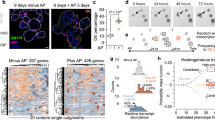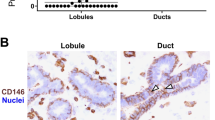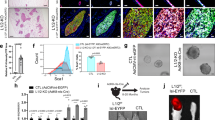Abstract
Tumorigenesis is a clonal evolution process that is initiated from single cells within otherwise histologically normal tissue1. It is unclear how single, sporadic mutant cells that have sustained oncogenic alterations evolve within a tightly regulated tissue environment. Here we investigated the effects of inducing oncogene expression in single cells in organotypic mammary acini as a model to elucidate the processes by which oncogenic alterations initiate clonal progression from organized epithelial environments. Sporadic cells induced to overexpress oncogenes that specifically perturb cell-cycle checkpoints (for example, E7 from human papilloma virus 16, and cyclin D1), deregulate Myc transcription or activate AKT signalling remained quiescent within growth-arrested acini. By contrast, single cells that overexpress ERBB2 initiated a cellular cascade involving cell translocation from the epithelial layer, as well as luminal outgrowth that is characteristic of neoplastic progression in early-stage epithelial tumours. In addition, ERBB2-mediated cell translocation to the lumen was found to depend on extracellular-regulated kinase and matrix metalloproteinase activities, and genetic alterations that perturb local cell–matrix adhesion drove cell translocation. We also provide evidence that luminal cell translocation may drive clonal selection by promoting either the death or the expansion of quiescent oncogene-expressing cells, depending on whether the pre-existing alterations allow anchorage-independent survival and growth. Our data show that the initial outgrowth of single oncogene-expressing cells from organized epithelial structures is a highly regulated process, and we propose that a cell translocation mechanism allows sporadic mutant cells to evade suppressive micro-environments and elicits clonal selection for survival and proliferative expansion outside the native niches of these cells.
This is a preview of subscription content, access via your institution
Access options
Subscribe to this journal
Receive 51 print issues and online access
$199.00 per year
only $3.90 per issue
Buy this article
- Purchase on Springer Link
- Instant access to full article PDF
Prices may be subject to local taxes which are calculated during checkout




Similar content being viewed by others
References
Nowell, P. C. The clonal evolution of tumor cell populations. Science 194, 23–28 (1976)
Dolberg, D. S. & Bissell, M. J. Inability of Rous sarcoma virus to cause sarcomas in the avian embryo. Nature 309, 552–556 (1984)
Holst, C. R. et al. Methylation of p16INK4a promoters occurs in vivo in histologically normal human mammary epithelia. Cancer Res. 63, 1596–1601 (2003)
Illmensee, K. & Mintz, B. Totipotency and normal differentiation of single teratocarcinoma cells cloned by injection into blastocysts. Proc. Natl Acad. Sci. USA 73, 549–553 (1976)
Jonason, A. S. et al. Frequent clones of p53-mutated keratinocytes in normal human skin. Proc. Natl Acad. Sci. USA 93, 14025–14029 (1996)
Michaloglou, C. et al. BRAFE600-associated senescence-like cell cycle arrest of human naevi. Nature 436, 720–724 (2005)
Weaver, V. M. et al. Reversion of the malignant phenotype of human breast cells in three-dimensional culture and in vivo by integrin blocking antibodies. J. Cell Biol. 137, 231–245 (1997)
Slamon, D. J. et al. Human breast cancer: correlation of relapse and survival with amplification of the HER-2/neu oncogene. Science 235, 177–182 (1987)
Hebner, C., Weaver, V. M. & Debnath, J. Modeling morphogenesis and oncogenesis in three-dimensional breast epithelial cultures. Annu. Rev. Pathol. 3, 313–339 (2008)
Kajita, M. et al. Interaction with surrounding normal epithelial cells influences signalling pathways and behaviour of Src-transformed cells. J. Cell Sci. 123, 171–180 (2010)
Hogan, C. et al. Characterization of the interface between normal and transformed epithelial cells. Nature Cell Biol. 11, 460–467 (2009)
Pearson, G. W. & Hunter, T. Real-time imaging reveals that noninvasive mammary epithelial acini can contain motile cells. J. Cell Biol. 179, 1555–1567 (2007)
Lincoln, D. W., II & Bove, K. The transcription factor Ets-1 in breast cancer. Front. Biosci. 10, 506–511 (2005)
Bershadsky, A. D., Balaban, N. Q. & Geiger, B. Adhesion-dependent cell mechanosensitivity. Annu. Rev. Cell Dev. Biol. 19, 677–695 (2003)
Gibson, M. C. & Perrimon, N. Extrusion and death of DPP/BMP-compromised epithelial cells in the developing Drosophila wing. Science 307, 1785–1789 (2005)
Li, X., Han, Y. & Xi, R. Polycomb group genes Psc and Su(z)2 restrict follicle stem cell self-renewal and extrusion by controlling canonical and noncanonical Wnt signaling. Genes Dev. 24, 933–946 (2010)
Rosenblatt, J., Raff, M. C. & Cramer, L. P. An epithelial cell destined for apoptosis signals its neighbors to extrude it by an actin- and myosin-dependent mechanism. Curr. Biol. 11, 1847–1857 (2001)
Davis, M. A., Ireton, R. C. & Reynolds, A. B. A core function for p120-catenin in cadherin turnover. J. Cell Biol. 163, 525–534 (2003)
Partanen, J. I., Nieminen, A. I., Makela, T. P. & Klefstrom, J. Suppression of oncogenic properties of c-Myc by LKB1-controlled epithelial organization. Proc. Natl Acad. Sci. USA 104, 14694–14699 (2007)
Shen, J. & Dahmann, C. Extrusion of cells with inappropriate Dpp signaling from Drosophila wing disc epithelia. Science 307, 1789–1790 (2005)
Bullen, T. F. et al. Characterization of epithelial cell shedding from human small intestine. Lab. Invest. 86, 1052–1063 (2006)
Marshall, T. W., Lloyd, I. E., Delalande, J. M., Nathke, I. & Rosenblatt, J. The tumor suppressor adenomatous polyposis coli controls the direction a cell extrudes from an epithelium. Mol. Biol. Cell 22, 3962–3970 (2011)
Brawley, C. & Matunis, E. Regeneration of male germline stem cells by spermatogonial dedifferentiation in vivo. Science 304, 1331–1334 (2004)
Aman, A. & Piotrowski, T. Cell migration during morphogenesis. Dev. Biol. 341, 20–33 (2010)
Debnath, J. et al. The role of apoptosis in creating and maintaining luminal space within normal and oncogene-expressing mammary acini. Cell 111, 29–40 (2002)
Gunawardane, R. N. et al. Novel role for PDEF in epithelial cell migration and invasion. Cancer Res. 65, 11572–11580 (2005)
Acknowledgements
We thank S. Valastyan, T. Muranen and W. Lee for critical reading of the manuscript. We thank the members of the Brugge laboratory for comments and discussion, the Nikon Imaging Center at Harvard Medical School for providing imaging equipment and software, and the laboratory of G. Danuser for imaging software support. This work was supported by a grant from the National Cancer Institute (CA080111, to J.S.B.) and an American Cancer Society postdoctoral fellowship (C.T.L.).
Author information
Authors and Affiliations
Contributions
C.T.L. conceived the study, performed the experiments, analysed the data and drafted the manuscript. J.S.B. supervised the study and edited the manuscript.
Corresponding author
Ethics declarations
Competing interests
The authors declare no competing financial interests.
Supplementary information
Supplementary Information
This file contains Supplementary Figures 1-16 with legends, Legends for Supplementary Movies 1-2 and Supplementary Tables 1-8. (PDF 1848 kb)
Supplementary Movie 1
This file shows a movie of single ErbB2 or GFP control cells within Day16 MCF10A acini (see Supplementary Information file for full legend). (MOV 1825 kb)
Supplementary Movie 2
This file shows a movie of single ErbB2 cell translocation and first division in the lumen (see Supplementary Information file for full legend). (MOV 1053 kb)
Rights and permissions
About this article
Cite this article
Leung, C., Brugge, J. Outgrowth of single oncogene-expressing cells from suppressive epithelial environments. Nature 482, 410–413 (2012). https://doi.org/10.1038/nature10826
Received:
Accepted:
Published:
Issue Date:
DOI: https://doi.org/10.1038/nature10826
This article is cited by
-
Pleiotropic effects of cell competition between normal and transformed cells in mammalian cancers
Journal of Cancer Research and Clinical Oncology (2023)
-
Matrix mechanics regulates epithelial defence against cancer by tuning dynamic localization of filamin
Nature Communications (2022)
-
Epithelial cells remove precancerous cells by cell competition via MHC class I–LILRB3 interaction
Nature Immunology (2021)
-
S100A8/A9 mediate the reprograming of normal mammary epithelial cells induced by dynamic cell–cell interactions with adjacent breast cancer cells
Scientific Reports (2021)
-
The COX-2/PGE2 pathway suppresses apical elimination of RasV12-transformed cells from epithelia
Communications Biology (2020)
Comments
By submitting a comment you agree to abide by our Terms and Community Guidelines. If you find something abusive or that does not comply with our terms or guidelines please flag it as inappropriate.



